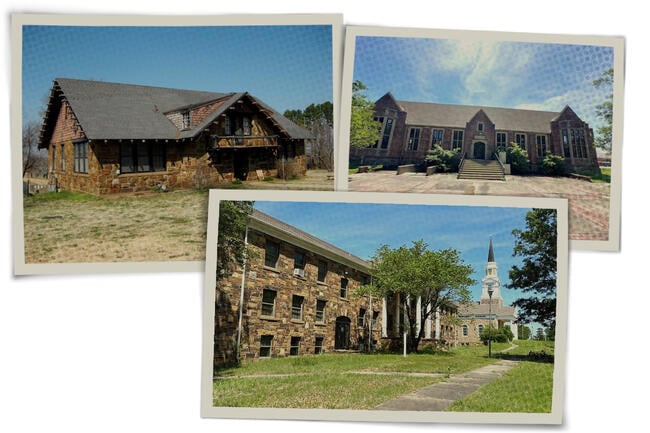You have /5 articles left.
Sign up for a free account or log in.

Founded in the 1860s, Bacone will now be forced to sell off its campus.
Photo illustration by Justin Morrison/Inside Higher Ed | TulGuy and Uyvsdi/Wikimedia Commons
Almost a year after declaring bankruptcy in a long-shot attempt at staying alive, Bacone College was ordered to liquidate its assets, ending hope for a revival, The Muskogee Phoenix reported.
“My understanding is this is the death of Bacone,” acting president Leslie Hannah told the newspaper, adding that he had been advised by legal counsel “to cease all operations.”
The small, private college in rural Oklahoma declared bankruptcy last June amid existential financial threats as lawsuits from unpaid vendors added up. Bacone narrowly avoided having its campus auctioned off to pay those bills. Facing such severe financial issues, the college essentially shut down but did not announce closure, as officials hoped to be absorbed by another institution.
Bacone, which served a majority Native American population, had struggled financially for years. Its enrollment collapsed from nearly 1,000 students in fall 2013 to just 106 in fall 2023, according to federal data. The college temporarily closed in early 2018 after then-president Frank Willis told the community, “We’ve run out of money,” and announced broad layoffs. Bacone enrolled nearly 900 students at the time and never recovered from the short-lived closure.
Bacone’s inability to gain tribal college status, and the federal funding that would come with it, was another challenge. The roots of the college trace back to the 1860s, when Almon C. Bacone, a white Christian missionary, established a boarding school for Native American children. That school would grow to become Indian University by 1880 and later adopt its founder’s name. The college made a splash in the art world in the 1930s when it helped elevate Native American art and produced numerous artists who contributed to what became known as the “Bacone style,” which emphasized action, bright colors and a flat painting method.
Officials emphasized their commitment to Native American students in court filings last year.
“Although it has experienced financial setbacks and needs the court’s help to reorganize under the bankruptcy code, Debtor intends to fulfill its mission to education [sic] Native American students within a nurturing Christian environment,” legal counsel wrote in the bankruptcy filing.
But now the dream of reorganization appears to be dead—and with it, Bacone College.
Bacone filed for Chapter 11 bankruptcy last June, which would have allowed it to reorganize. However, a U.S. Department of Justice trustee assigned to the case moved earlier this month to convert it to Chapter 7 bankruptcy and thus liquidation, because of alleged “gross mismanagement” by Bacone officials and “failure to timely provide information reasonably requested by the United States Trustee.”
That trustee, Ilene J. Lashinsky, wrote in a court filing that Hannah paid himself $16,410 through the college, allegedly to repay a $15,000 loan from the Small Business Administration, which the acting president previously took out to meet Bacone’s payroll.
“This case is stagnant and the Debtor’s only hope is that an investor may come in and purchase the real estate assets of the Debtor,” Lashinsky wrote. “This is the best option for creditors to get paid.”
A judge signed off on an order to convert the case to Chapter 7 bankruptcy last week. Court documents estimated the value of Bacone’s 160-acre campus at just under $3.8 million. Additionally, court documents listed the value of Bacone’s famous art collection as “unknown.”




